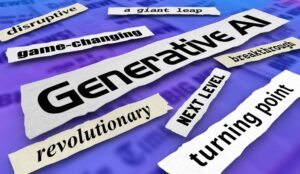
2024 GenAI Predictions: Part Deux

(amgun/Shutterstock)
Declaring that interest in generative AI will grow in 2024 is the easiest prediction in the history of predictions. The more interesting bits are how GenAI adoption will unfold this year, what impact it will have on businesses, and whether there will be unintended side effects on society.
To answer these questions, we turn to our panel of GenAI experts from industry. The fun starts with Nick Elprin, the CEO and co-founder of Domino Data Lab, who sees GenAI unlocking the most valuable of enterprise assets: unstructured data. But the new focus on unstructured data won’t be all sunshine and unicorns, he warns.
“Unstructured data–primarily internal document repositories–will become an urgent focus for enterprise IT and data governance teams,” Elprin says. “These repositories of content have barely been used in operational systems and traditional predictive models to date, so they’ve been off the radar of data and governance teams. GenAI-based chat bots and fine-tuned foundation models will unlock a host of new applications of this data, but will also make governance critical. Companies who have rushed to develop GenAI use cases without having implemented the necessary processes and platforms for governing the data and GenAI models will find their projects trapped in PoC purgatory, or worse. These new requirements will give rise to specialized tools and technology for governing unstructured data sources.”
2024 will be the year of pragmatic AI, or AI solutions that add actual value, predicts Chad Dunavant, EVP and chief product and strategy officer for CSG.
“We’re seeing some far-fetched AI use cases, partly fueled by the proliferation of new GenAI services hitting the market,” Dunavent says. “In 2024, we’ll see a real shift from companies launching GenAI services simply for the sake of it toward more investment in solutions and services that add value. The services that will win will be those that make the current processes better.”
All sorts of business processes will be impacted by GenAI in 2024, says Ken Englund, the Americas TMT leader for EY.
“In 2024, all eyes will be on emerging technologies like GenAI, LLMs and industry-specific co-pilots to rethink virtually every operational activity, including supply chain optimization, automation, risk management, customer alignment and new business development,” Englund says. “Companies coming out ahead are experimenting with GenAI in targeted front- and back-office use cases, establishing an AI control tower to guide transformation efforts, investing in new forms of digital infrastructure in the burgeoning ‘edge economy,’ and harnessing platform business models to industrialize and scale advancing technologies, among other key opportunities.”
GenAI deployments have been all over the map up to this point. In 2024, businesses will start to hammer GenAI into shape thanks to AIOps tools and techniques, predicts Ugo Orsi, chief customer officer at Digitate.
“As GenAI continues to gain momentum in mainstream business, expect to see a ‘leveling out’ in 2024 as enterprises begin to adopt standards and deploy GenAI in applications that make business sense as they pair it with AIOps,” Orsi says.
If you have a business opportunity in 2024, chances are good someone will frame it in GenAI terms, predicts Jaret Chiles, the chief services officer at DoiT International
“It will become difficult to discuss any product or solution without AI creeping into the discussion,” Chiles says. “While there will be many new AI products entering the market, a big piece of the shift will be many existing products on the market having AI retrofit to increase the value they produce for consumers. More automated recommendation engines, and automated adaptations, based on behavioral analysis of users and services.”
The democratization GenAI is set to transform workplaces by breaking down barriers and making collective knowledge accessible across roles, predicts Russell Sherman, CTO and cofounder of Viso Trust.
“It’s not just a trend; it’s an evolution in how we work and learn,” Sherman says. “Significance of the trend: GenAI’s democratization isn’t just about boosting productivity and efficiency; it’s about empowering everyone, regardless of technical expertise, to contribute and innovate. However, as we embrace this transformation, it’s crucial to acknowledge the concerns it brings, especially around security. Our journey toward progress should be both inclusive and secure.”
Companies that have been scouring the world for available GPUs will get a welcome respite in 2024, predicts Kjell Carlsson, the head of data science strategy and evangelism at Domino Data Lab.
“Gone are the days when you had to beg, borrow and steal GPUs for GenAI,” Carlsson says. “The combination of a shift from giant, generic LLMs to smaller, specialized models, plus increased competition in infrastructure and also quickly ramping production of new chips accelerated for training and inferencing deep learning models together mean that scarcity is a thing of the past. However, investors don’t need to worry in 2024, as the market won’t collapse for at least another year.”
GenAI’s star has burned brightly for the past year. Alas, GenAI may have already run out of fuel, predicts Ryan Welsh, the founder and CEO of Kyndi
“Without a doubt, GenAI is a major leap forward,” Welsh says. “However, many people have wildly overestimated what is actually possible. Although generated text, images and voices can seem incredibly authentic and appear as if they were created with all the thoughtfulness and the same desire for accuracy as a human, they are really just statistically relevant collections of words or images that fit together well (but in reality, may be completely inaccurate). The good news is the actual outputs of AI can be incredibly useful if all of their benefits and limitations are fully considered by the end user.”
Ontotext founder and CEO Atanas Kiryakov isn’t predicting a collapse of GenAI investment in 2024. But to truly benefit from GenAI, he’s saying they must get back to basics–i.e. focus on the data.
“While corporate pressures may prompt organizations to do something with AI, being data driven must come first and remain top priority,” Kiryakov says. “After all, ensuring data is organized, shareable, and interconnected is just as critical as asking whether GenAI models are trusted, reliable, deterministic, explainable, ethical, and free from bias.”
Data analysts will get value out of GenAI in 2024, says Ed Thompson, CTO at Matillion. But as they try to use it for analyzing bigger and bigger data sets, they’ll find the limits of the tech.
“The big limitation of GenAI and LLMs is the amount of data that they can interpret as a whole,” Thompson says. “It is almost like a goldfish reading a book–it can only remember 10 pages at a time, so is missing that legacy context. That’s going to limit your understanding of the novel as you get further into the book. So, if you’re thinking of putting a large data set into a model and asking it to analyse that large data set, it’s going to be limited by its context. Until that is remedied however, the use-cases are still very much there, with AI taking on the boilerplate work and empowering users to do less of the run-of-the-mill tasks day to day.”
An overconfidence in GenAI code will lead to generated AI vulnerabilities, predicts Phil Nash, a developer advocate with Sonar.
“As more and more developers use GenAI to successfully help build their products, 2024 will see the first big software vulnerabilities attributed to AI generated code,” Nash says. “The success of using AI tools to build software will lead to overconfidence in the results and ultimately a breach that will be blamed on the AI itself. This will lead to a redoubling across the industry of previous development practices to ensure that all code, written by both developers and AI, is analyzed, tested, and compliant with quality and security standards.”
Organizations will struggle to adopt and leverage GenAI successfully in 2024, predicts Angel Viña, the CEO of Denodo.
“Organizations are encountering multiple challenges as they attempt to implement GenAI and LLMs, including issues with data quality, governance, ethical compliance, and cost management,” Viña says. “Each obstacle has direct or indirect ties to an organization’s overarching data management strategy, affecting the organization’s ability to ensure the integrity of the data fed into AI models, abide by complex regulatory guidelines, or facilitate the model’s integration into existing systems.”
As AI regulation evolves, clarity around liability will be a catalyst for progress and adoption, predicts Joe Regensburger, the vice president of research and AI for small and medium-sized enterprises at Immuta.
“One of the biggest questions about AI going into 2024 is centered around liability,” Regensburger says. “The EU’s AI Act is proposing restrictions on the purposes for which AI can be employed, placing more scrutiny on high-risk applications, but President Biden’s October 30th executive order concerning AI took a slightly different tune, focusing on the vetting and reviewing of models and imposing restrictions and standards based on that. On both sides, liability and indemnity remain murky. In 2024, as these regulations fall into place, industry leaders will begin to get more clarity around who is liable for what and AI insurance will emerge as regulators and industry leaders look to harden the vetting and reviewal process, both in production and in development.”
Customization will be the name of the game in 2024 as companies realize that out-of-the-box foundation models don’t cut the mustard, predicts Brian Peterson, the CTO and co-founder of Dialpad.
“In 2024, we will see the initial hype around large foundational AI LLMs fade as companies realize that one size does not fit all,” Peterson says. “While the introduction of AI tools like ChatGPT was impressive, the enterprise will not benefit from solutions that pull from the entire internet. Instead, businesses are going to move away from leveraging large LLMs, leaning toward more specialized solutions and LLMs that are trained on a more bespoke and curated dataset. Not only will these produce more tailored results, but they are also more secure and cost-efficient. Businesses will embrace AI that is tailored to them and their customers to improve accuracy, avoid hallucination and, ultimately, increase productivity and revenue.”
After all the bluff and bluster, companies will start to demand actual results from GenAI, predicts Eric Williamson, Chief Marketing Officer at CallMiner,
“More business leaders will come around to the idea that GenAI is not a silver bullet – and it is most powerful when used for specific use cases, often along with other AI techniques, to meet specific business needs,” Williamson says. “I predict that the organizations who ‘get it right’ will be the ones that effectively balance AI velocity and agility with responsibility and security. Those that do this will find themselves in the position to deliver the most value to their customers and improve the bottom line.”
Related Items:
2024 GenAI Predictions: Part One
GenAI Hype Bubble Refuses to Pop
When GenAI Hype Exceeds GenAI Reality































